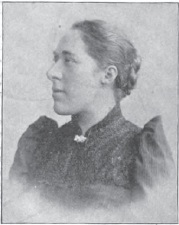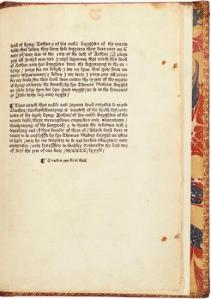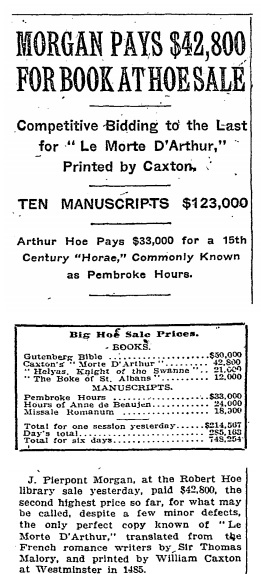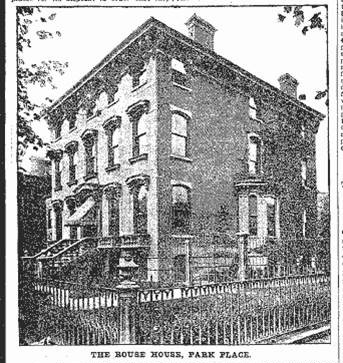
Mrs. Norton Q. Pope, photograph from Laura Geddes Smith, “Law Lectures for Women at the University of the City of New York,” The University Magazine vol. 10, no. 6 (June 1894): p. 256.
Abby Ellen Pope was one of the earliest American women book collectors to achieve national fame for her collection, although much of her life remains mysterious. The descriptions of her magnificent library are tantalizing, but reveal little of the woman behind the collection. The most comprehensive source for her biography is an article by Charles Ryskamp, published in The Book Collector in 1984.
The bookseller Bernard Quaritch described Mrs. Pope as “a very strong minded looking woman.” A portrait of Mrs. Pope painted by Benjamin Constant was sold after her death and its present location is unknown. Until recently, there were no known photographs of her. I found a picture of Mrs. Pope in a magazine article about the Woman’s Legal Education Society, of which she was a founder and director.
Abby Ellen Hanscom was born in Massachusetts in 1858 to Charlotte Ellen Pratt and John Hanscom. The family moved to Chicago in 1872, then to Brooklyn around 1885. We have no information about Abby Hanscom’s early education or how she began to collect books at such a high level. Early on, Abby must have received financial support from her father, a businessman who may or may not have been a book collector himself. Afterwards, her husband Norton Q. Pope apparently took an interest in book collecting as well, and certainly supported her own efforts.
In 1885 at the age of 27, Miss Abby Hanscom of Brooklyn suddenly emerged full-fledged as a serious book collector. Her triumph at the Osterley Park sale of Lord Jersey’s library is the most widely cited anecdote about this accomplished collector. At that sale, she outbid the British Museum to acquire one of the greatest books in her collection, the only known perfect copy of Sir Thomas Malory’s Morte d’Arthur, printed in 1485 by William Caxton. According to The Literary Collector (1901), it sold for £1,950, but she paid two commissions on it: “one to her regular agent and one to the elder Quaritch, who purchased it.” It seems unlikely that this was in fact her first major book purchase. She must have started collecting books prior to the Osterley Park sale, in order to have the knowledge and confidence required to pursue something like the Caxton Malory.

Thomas Malory’s Morte d’Arthur, purchased by Abby Hanscom in 1885, now in the Morgan Library. Image courtesy The Morgan Library & Museum.
By the time of Miss Hanscom’s marriage to Norton Quincy Pope in 1887, her collection was already well established. An article in the Brooklyn Daily Eagle, describing their wedding, included a description of John Hanscom’s library and art room at 241 Park Place, “fitted up at a cost of $350,000.” It included “the original of the ‘Merry Tales of King Arthur,’ which cost Mr. Hanscom $15,000; the oldest edition of Shakespeare in this country, which costs $10,000, and the original manuscript of the majority of Robert Burns’ poems.” After marriage, Abby and her husband resided at 241 Park Place, where those books remained part of her own library. John Hanscom may have initially purchased the books and paid for the library fittings, but it seems clear that the collection belonged to Abby herself. All news articles after that date describe the library as Mrs. Pope’s, with no mention of her father.
The Popes’ house in Brooklyn has since been demolished, but I was able to find a newspaper article from 1901 that includes a photograph of the front of the house. According to the Brooklyn Eagle (April 10, 1892), the library was an elegant room in a wing of the house, 65 feet by 25 feet, with a dome and stained glass windows. “It is a beautiful and fitting resting place for the unique collections which fill it to overflowing–rare books, manuscripts, autographs, and objects of art. The bookcases which line the walls are of mahogany, and so fashioned that the title of every volume on the crimson morocco covered shelves can be seen. Opposite the entrance to the room there is a huge carved wood mantle shelf, surmounted by a sixteenth century ormolu clock of turquoise, with candelabra to match.”
From “The Library of a Brooklyn Bibliophile,” Pratt Institute Monthly (March 1894):
“This library, one of the choicest jewels of Brooklyn, it has been our privilege to examine, through the gracious hospitality of its owner; and by her kind permission we make mention here of some part of its rare and beautiful contents, reluctantly leaving undescribed many things of almost equal interest.
The room, which has been built especially to hold these riches, is worthy of the precious things it guards. The light is peculiarly pleasing; it enters from above, through flat skylights of artistic pale-tinted glass, and at night a soft brilliancy is shed by electric lights, also situated above the ceiling. …
Shelves, drawers, easels, book-cases, are all of choice woods and workmanship; the very cases that enshrine individual volumes of especial rarity and value are themselves good specimens of the binder’s art.”
Abby Pope collected illuminated manuscripts, incunabula, early English literature, Americana, fine bindings, and other great rarities. She was said to be particularly interested in perfect copies, and would wait patiently for the right book to appear. High points of her collection included:
- Missal of Charles VI of France
- Ptolemy’s Geography, 1478
- Shakespeare first, second, third, and fourth folios, and various quartos
- Caxton editions of Morte d’Arthur and Confessio Amantis
- Spenser’s Faerie Queene, first edition of both parts (1590, 1596)
- Zumarraga’s Doctrina Breve
- Hubbard’s Present State of New England
- John Norton’s Redeemed Captive
- Filson’s Kentucky
- Works of Robert Burns, extra-illustrated by Mrs. Pope with original mss
After such a promising beginning, Abby Pope’s life came to an abrupt end in 1894. While staying at their summer home in Maine near her parents, she died of apoplexy at the age of 36. In the aftermath of her death, everything changed. The following events seem more like a soap opera than real life, and raise more questions than they answer. In 1895, Norton Q. Pope disposed of his horses and farm equipment at their home in Maine, and the Hanscoms’ nearby summer home was destroyed by fire. Pope sold Abby’s entire library to Dodd, Mead & Co. and soon after disposed of the art and household goods from their home in Brooklyn. At the same time, Brooklyn society was surprised to learn of his marriage to Jennie Barnes, a cousin and companion of the late Mrs. Pope. Norton Q. Pope and his second wife moved to Boston.
Norton Q. Pope also had a falling out with Abby’s parents, with whom he had previously had a close relationship. In 1895, he brought suit against the Hanscoms regarding ownership of the Park Place property in which he and Abby had lived, which the Hanscoms had just sold to P.W. Rouss. John Hanscom, accused of failing to pay his creditors, apparently absconded with the remaining funds and moved to Maine with his wife. By December of 1895, the Hanscoms had Abby’s remains moved from Brooklyn to the Hanscom family plot in Maine. Two years later, after a short illness, Norton Q. Pope died of pneumonia.
T he book collector Robert Hoe bought a large portion of the Pope library from Dodd, Mead in 1896, with the remainder sold by Dodd, Mead in several catalogues mixed with other books. Hoe disposed of some duplicates and other materials from the Pope library in a Christie’s sale in 1902. The Robert Hoe library, still including many of Abby’s books, was sold in 1911. Most of the finest books from the Hoe sale were purchased by dealer George D. Smith for Henry E. Huntington, with one notable exception. After a spirited round of bidding, Belle da Costa Green, librarian of J.P. Morgan, triumphed over Smith and acquired the Caxton Malory at a price of $42,800. The New York Times reported that “her victory evoked a hearty round of applause, and a number of persons personally congratulated her.” The Hoe sale sparked renewed interest in Abby Pope, who was identified as the previous owner of the Caxton Malory. In a report of the sale on March 30, 1911, The Nation referred to her as “the most notable woman book-collector America has produced.”
he book collector Robert Hoe bought a large portion of the Pope library from Dodd, Mead in 1896, with the remainder sold by Dodd, Mead in several catalogues mixed with other books. Hoe disposed of some duplicates and other materials from the Pope library in a Christie’s sale in 1902. The Robert Hoe library, still including many of Abby’s books, was sold in 1911. Most of the finest books from the Hoe sale were purchased by dealer George D. Smith for Henry E. Huntington, with one notable exception. After a spirited round of bidding, Belle da Costa Green, librarian of J.P. Morgan, triumphed over Smith and acquired the Caxton Malory at a price of $42,800. The New York Times reported that “her victory evoked a hearty round of applause, and a number of persons personally congratulated her.” The Hoe sale sparked renewed interest in Abby Pope, who was identified as the previous owner of the Caxton Malory. In a report of the sale on March 30, 1911, The Nation referred to her as “the most notable woman book-collector America has produced.”
For such an important figure in American book collecting history, we still know relatively little about Abby Pope’s life or collection. No personal papers of hers are known to exist, and no complete catalogue of her library was ever printed. I hold out hope that one day her personal papers will be discovered somewhere in an attic in Brooklyn. Abby Pope accomplished so much in her short life; I wish we could have seen the book collection she might have built given more time.
Further Reading:
Ryskamp, Charles. “Abbie Pope: Portrait of a Bibliophile.” Book Collector (Spring 1984): 38-52.
“Pope, Abbie Ellen Hanscom.” In Dictionary of American Book Collectors, by Donald C. Dickinson (New York, 1986): pp. 262-263.
“Abbie Hanscom Pope.” In Dictionary of Literary Biography, Vol. 140: American Book-Collectors and Bibliographers, 1st Series , ed. by Joseph Rosenblum (Detroit, 1994): pp. 189-193
Update 11/8/16: After reviewing more primary sources, I have changed the spelling of Abby’s name from Abbie. While it is spelled multiple ways, the format “Abby E. Pope” is the one she most frequently used.

Abby Pope’s copy of the Shakespeare First Folio is in the Folger Shakespeare Library. She had paid the dealer B.F. Stevens $3925. for it. The book subsequently went into the Hoe collection, and then was acquired by the Folgers.